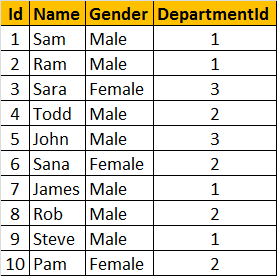Stored procedures with output parameters - Part 19
In this video, we will learn about, creating stored procedures with output parameters. Please watch Part 18 of this video series, before watching this video.

To create an SP with output parameter, we use the keywords OUT or OUTPUT. @EmployeeCount is an OUTPUT parameter. Notice, it is specified with OUTPUT keyword.
Create Procedure spGetEmployeeCountByGender
@Gender nvarchar(20),
@EmployeeCount int Output
as
Begin
Select @EmployeeCount = COUNT(Id)
from tblEmployee
where Gender = @Gender
End
To execute this stored procedure with OUTPUT parameter
1. First initialise a variable of the same datatype as that of the output parameter. We have declared @EmployeeTotal integer variable.
2. Then pass the @EmployeeTotal variable to the SP. You have to specify the OUTPUTkeyword. If you don't specify the OUTPUT keyword, the variable will be NULL.
3. Execute
Declare @EmployeeTotal int
Execute spGetEmployeeCountByGender 'Female', @EmployeeTotal output
Print @EmployeeTotal
If you don't specify the OUTPUT keyword, when executing the stored procedure, the @EmployeeTotal variable will be NULL. Here, we have not specified OUTPUT keyword. When you execute, you will see '@EmployeeTotal is null' printed.
Declare @EmployeeTotal int
Execute spGetEmployeeCountByGender 'Female', @EmployeeTotal
if(@EmployeeTotal is null)
Print '@EmployeeTotal is null'
else
Print '@EmployeeTotal is not null'
You can pass parameters in any order, when you use the parameter names. Here, we are first passing the OUTPUT parameter and then the input @Gender parameter.
Declare @EmployeeTotal int
Execute spGetEmployeeCountByGender @EmployeeCount = @EmployeeTotal OUT, @Gender = 'Male'
Print @EmployeeTotal
The following system stored procedures, are extremely useful when working procedures.
sp_help SP_Name : View the information about the stored procedure, like parameter names, their datatypes etc. sp_help can be used with any database object, like tables, views, SP's, triggers etc. Alternatively, you can also press ALT+F1, when the name of the object is highlighted.
sp_helptext SP_Name : View the Text of the stored procedure
sp_depends SP_Name : View the dependencies of the stored procedure. This system SP is very useful, especially if you want to check, if there are any stored procedures that are referencing a table that you are abput to drop. sp_depends can also be used with other database objects like table etc.
Note: All parameter and variable names in SQL server, need to have the @symbol.

To create an SP with output parameter, we use the keywords OUT or OUTPUT. @EmployeeCount is an OUTPUT parameter. Notice, it is specified with OUTPUT keyword.
Create Procedure spGetEmployeeCountByGender
@Gender nvarchar(20),
@EmployeeCount int Output
as
Begin
Select @EmployeeCount = COUNT(Id)
from tblEmployee
where Gender = @Gender
End
To execute this stored procedure with OUTPUT parameter
1. First initialise a variable of the same datatype as that of the output parameter. We have declared @EmployeeTotal integer variable.
2. Then pass the @EmployeeTotal variable to the SP. You have to specify the OUTPUTkeyword. If you don't specify the OUTPUT keyword, the variable will be NULL.
3. Execute
Declare @EmployeeTotal int
Execute spGetEmployeeCountByGender 'Female', @EmployeeTotal output
Print @EmployeeTotal
If you don't specify the OUTPUT keyword, when executing the stored procedure, the @EmployeeTotal variable will be NULL. Here, we have not specified OUTPUT keyword. When you execute, you will see '@EmployeeTotal is null' printed.
Declare @EmployeeTotal int
Execute spGetEmployeeCountByGender 'Female', @EmployeeTotal
if(@EmployeeTotal is null)
Print '@EmployeeTotal is null'
else
Print '@EmployeeTotal is not null'
You can pass parameters in any order, when you use the parameter names. Here, we are first passing the OUTPUT parameter and then the input @Gender parameter.
Declare @EmployeeTotal int
Execute spGetEmployeeCountByGender @EmployeeCount = @EmployeeTotal OUT, @Gender = 'Male'
Print @EmployeeTotal
The following system stored procedures, are extremely useful when working procedures.
sp_help SP_Name : View the information about the stored procedure, like parameter names, their datatypes etc. sp_help can be used with any database object, like tables, views, SP's, triggers etc. Alternatively, you can also press ALT+F1, when the name of the object is highlighted.
sp_helptext SP_Name : View the Text of the stored procedure
sp_depends SP_Name : View the dependencies of the stored procedure. This system SP is very useful, especially if you want to check, if there are any stored procedures that are referencing a table that you are abput to drop. sp_depends can also be used with other database objects like table etc.
Note: All parameter and variable names in SQL server, need to have the @symbol.
No comments:
Post a Comment